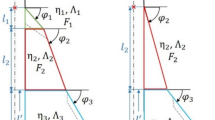Abstract
Flows around vortex generators (VGs), which serve as one of the important flow control methods, are investigated by solving Reynolds-averaged Navier-Stokes (RANS) equations. The influences on the main flow of VGs are intended to explore. Firstly, the flow around a single VG on a flat plane is computed to validate the schemes and to acquire basic knowledge of this kind of flow. Secondly, transonic flow past a standard model, named by ONERA-M6 wing, is predicted to investigate the flow features of shockwave/boundary-layer interactions (SWBLI). Thirdly, the effects of a row of VGs mounted about 25% local chord on a supercritical wing are analyzed in transonic condition with strong SWBLI. Lastly, VGs are mounted more upwind (about 3.5% local chord) to explore the effects at low speed and high incidence condition. The numerical results show that seven VGs can effectively suppress the separations behind the strong SWBLI and decrease spanwise flow and wing-tip vortex in transonic condition. VGs also can decrease the large scope of separation over the wing at low speed with high angle of attack.
Similar content being viewed by others
References
Vos J B, Rizzi A, Darracq D, et al. Navier-Stokes solvers in European aircraft design. Progr Aero Sci, 2002, 38: 601–697
Liu G, Liu W, Mou B, et al. CFD numerical simulation investigation of vortex generators. Acta Aerodyn Sin, 2007, 25(2): 241–244
Ni Y Q. Develoment of the vortex-generator and study on the effect of vortex-generator on boundary layer. Acta Aerodyn Sin, 1995, 13: 110–116
Lin J C. Review of research on low-profile vortex generators to control boundary-layer separation. Progr Aero Sci, 2002, 38: 389–420
Yao C S, Lin J C, Allan B G. Flow-field measurement of device- induced embedded streamwise vortex on a flat plate. AIAA, 2002-3162
Allan B G, Yao C S, Lin J C. Simulation of embedded streamwise vortices on a flat plate. NASA/CR-2002-211654, ICASE Report, 2002-14
Jirasek A. A vortex generator model and its application to flow control. AIAA, 2004-4965
Erik W, Scott T S. Numerical simulation of micro vortex generators. AIAA, 2004-2697
Zhang J, Zhang B Q. Investigation of boundary layer separation control for supercritical airfoil using micro vortex generator (in Chinese). J Exp Fluid Mech, 2005, 19(3): 94–97
Valilis P S, Ekaterinaris J A. Computational investigation of flow control over wings. AIAA, 2007-477
Stillfried F, Lögdberg O, Wallin S, et al. Statistical modeling of the influence of turbulent flow separation control devices. AIAA, 2009-1501
Xiao Z X. Study of complex flow by solving NS equations and application of turbulence models (in Chinese). Doctoral Dissertation. Northwestern Polytech University, 2003
Xiao Z X. RANS/LES hybrid method based on aircraft design (in Chinese). Postdoc Final Report. Beijing: Tsinghua University, 2005
Xiao Z X, Chen H X, Zhang Y F, et al. Study of delayed-detached eddy simulation with weakly nonlinear turbulence model. J Aircraft, 2006, 43: 1377–1385
Fu S, Xiao Z X, Chen H X, et al. Simulation of wing-body junction flows with hybrid RANS/LES methods. Int J Heat Fluid Flow, 2007, 28: 1379–1390
Xiao Z X, Zhang Y F, Huang J B, et al. Prediction of separation flows around a 6:1 prolate spheroid using RANS/LES hybrid approaches. Acta Mech Sin, 2007, 23(4): 369–382
Xiao Z X, Fu S. Studies of the unsteady supersonic base flows around three afterbodies. Acta Mec Sin, 2009, 25(4): 471–479
Soo H P, Jang H K. Implementation of k-ω turbulence models in an implicit multigrid method. AIAA J, 2004, 42(7): 1348–1357
Durbin P A. On the k-ɛ stagnation point anomaly. Int J Heat Fluid Flow, 1996, 17(1): 89–90
Menter F R. Two-equation eddy-viscosity turbulence models for engineering applications. AIAA J, 1994, 32: 1598–1605
Wilcox D C. Reassessment of the scale-determining equation for advanced turbulence models. AIAA J, 1988, 26(11): 1299–1310
Author information
Authors and Affiliations
Corresponding author
Rights and permissions
About this article
Cite this article
Huang, J., Xiao, Z., Fu, S. et al. Study of control effects of vortex generators on a supercritical wing. Sci. China Technol. Sci. 53, 2038–2048 (2010). https://doi.org/10.1007/s11431-009-3240-0
Received:
Accepted:
Published:
Issue Date:
DOI: https://doi.org/10.1007/s11431-009-3240-0




